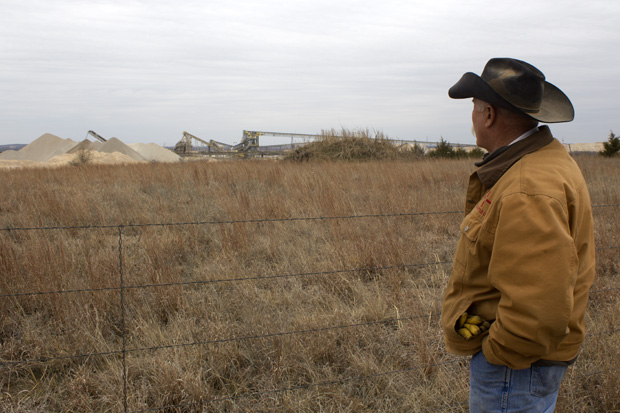
Johnston County Landowner Clyde Runyon just outside a limestone mining operation near Mill Creek, Okla.
Logan Layden / StateImpact Oklahoma


Johnston County Landowner Clyde Runyon just outside a limestone mining operation near Mill Creek, Okla.
Logan Layden / StateImpact Oklahoma

Logan Layden / StateImpact Oklahoma
Johnston County Landowner Clyde Runyon just outside a limestone mining operation near Mill Creek, Okla.
Limestone and sand miners are getting a lot of attention lately. The amount of groundwater they can displace from the Arbuckle-Simpson Aquifer was recently capped, and the state House could authorize a new tax on the industry.
That’s not all. The Oklahoma Department of Mines has an unusual permitting process some landowners say leaves them feeling helpless when a new mine is proposed, and they want that process changed.
“It’s really screwed up,” Citizens for the Protection of the Arbuckle-Simpson Aquifer President Amy Ford says.

First, an application to mine is made. Then it’s time for informal conferences. In an email, Department of Mines Minerals Division Director Bret Sholar says the informal conference opens communication between the mining company and public without the expense of a legal proceeding. But Ford says it’s mostly just for show.
“There’s no admission of evidence, anything,” Ford says. “It’s just kind of a — somebody from the Department of Mines, or sometimes a hearing examiner, just kind of sits in there and listens to everybody.”
After the informal conferences, the Department of Mines decides to issue a permit.
“Those that have participated in the informal conference are notified of this and allowed to file a request for a formal hearing,” Ford says.
So the first formal public hearing doesn’t happen until after the decision to issue a permit is made. For most agencies, the opposite is true.
“You’re climbing an uphill battle,” Ford says.
Senate Bill 1184, by State Sen. Susan Paddack, D-Ada, would make the informal conferences formal hearings, with evidence and testimony, before a permit application is decided on. The bill’s future is uncertain, but it was passed unanimously by the Energy Committee, and awaits more action by the full Senate.
Local rancher Clyde Runyon says he fought most of the mines in this area — in vain — and hopes the formal hearings will help slow the permitting process down at least.
The signs of mining are clear from the highway, but to get a real sense of the size of these operations, you have to navigate the grid of dusty county roads Runyon knows by heart. There are craters in the earth football stadiums would disappear into; some empty, some filled with clear groundwater. If combined, the mines would take up about the same space as the nearby City of Ada.
“Go just a little further south and there’s a hole in the ground probably, oh my gosh, I want to say it’s well over half a mile deep,” Runyon says. “There’s seven of them, just almost in line right through here.”
Sholar says it’s extremely rare for the Oklahoma Department of Mines to deny a mining permit application.
“At some point it just might get held up, but flat out denying it, I can’t recall myself when we’ve done it. Not in my time here,” Sholar says.
Ford says that’s because of the agency’s unique permitting process.
Clarification: Any earlier version of this story indicated that, after the informal hearing process, the Department of Mines issues a permit. In actuality, after the informal hearing process, the Department of Mines only makes a decision to issue a permit. The permit doesn’t go into effect until after the formal hearing process.